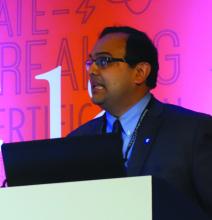ORLANDO – The use of an instantaneous wave-free ratio (iFR)–guided strategy to identify physiologically significant coronary stenoses that warrant revascularization proved substantially more cost effective than did a fractional flow reserve (FFR)–based strategy in a prespecified secondary analysis of the randomized DEFINE-FLAIR trial, Manesh R. Patel, MD, reported at the annual meeting of the American College of Cardiology.
The difference in total health care costs over the course of a year of follow-up was $896 per patient in favor of the instantaneous wave-free ratio (iFR) approach, said Dr. Patel, a professor of medicine, the chief of the division of cardiology, and the chief of the division of clinical pharmacology at Duke University in Durham, N.C.
“Will this change our practice? I hope so. I will say that, over the last year [since publication of the DEFINE-FLAIR primary results], we have seen an increase in utilization, and a lot of the conversation at this meeting is about coronary physiology,” the cardiologist said.DEFINE-FLAIR was a multicenter study in which 2,492 patients with coronary artery disease were randomized to undergo either iFR- or FFR-guided coronary revascularization. It had previously been established that decision making regarding coronary revascularization or deferral that was guided by FFR leads to better patient outcomes than decision making guided by angiography alone.
DEFINE-FLAIR showed that iFR provides clinical benefits similar to those of FFR. The 1-year primary endpoint, a composite of all-cause mortality, nonfatal MI, or unplanned revascularization, occurred in 6.8% of the iFR group and 7.0% of the FFR group, while the revascularization rate was significantly lower in the iFR group, by a margin of 47.5% to 53.4% (N Engl J Med. 2017 May 11;376(19):1824-34).
Dr. Patel presented a formal study of total health care costs and quality of life in the two study arms through 1 year of follow-up. The cost of coronary physiologic assessment by iFR was lower because, unlike FFR, iFR doesn’t use adenosine for vasodilation. Plus, median procedural time was 4.5 minutes shorter in the iFR group, resulting in lower costs for staff time. After investigators added up the costs of balloons, stents, laboratory testing, and a year’s worth of primary care visits, specialty consults, and unplanned revascularization procedures, the total cost per patient was $7,442.23 in 2017 U.S. dollars in the iFR group and $8,243.39 in the FFR group.
Session cochair Christopher Granger, MD, was favorably impressed.


